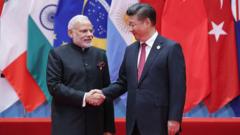As India's new wealthy population emerges, exclusive clubs like Soho House are reshaping social interactions, prioritizing creativity and community over traditional elitism. The demand for modern, accessible spaces contrasts starkly with the limited offerings of established gymkhanas.
New Wave of Exclusive Clubs Tops India's Social Scene

New Wave of Exclusive Clubs Tops India's Social Scene
India's affluent classes are moving away from traditional colonial-era clubs to modern members-only hangouts, embracing a new social dynamic.
In India, the landscape of exclusive social clubs is undergoing a significant transformation. Traditionally, the Indian elite have sought refuge in colonial-era clubs, complete with their formalities and longstanding traditions. However, as new wealth emerges in the country, there's a palpable shift towards more contemporary and inclusive members-only hangouts that reflect a modern ethos.
The appeal of old Raj-era clubs, with their dark wood interiors and stuffy dress codes, is waning as new millionaires seek fresh environments to network and socialize. As Asia's third-largest economy continues to flourish, the need for less formal and more relatable spaces has created opportunities for establishments like Soho House, which has plans to expand in major cities like Delhi and Mumbai.
Soho House, which started in London in the mid-1990s to challenge the traditional gentleman’s club model, offers a relaxed atmosphere aimed at creators and innovators. Its first Mumbai location, which opened six years ago on Juhu Beach, has proven immensely popular, highlighting a rising preference for spaces where young entrepreneurs can thrive away from the constraints of inherited wealth and lineage.
Kelly Wardingham, regional director of Soho House for Asia, emphasizes that modern members seek not just physical amenities but also opportunities for collaboration and mentorship. This sentiment is echoed by young creatives like filmmaker Reema Maya, who benefit from the vibrant community available through club memberships, a stark contrast to the exclusivity that characterized traditional gymkhanas.
Many established clubs still face long waiting lists for membership, often stretching for years, posing an obstacle to the burgeoning new class of self-made entrepreneurs. The increasing demand for alternatives has led to a surge in new clubs entering the Indian market, with reputable names like St Regis and Four Seasons joining the fray.
Despite their more inclusive policies, these new establishments still operate as high-end luxury venues, often costing significantly more than the average Indian’s monthly income. For instance, a membership at Soho House costs around 320,000 rupees (approximately $3,700), limiting access primarily to India's wealthier classes.
This shift towards modern private clubs reflects India's post-liberalization economic narrative. As wealth inequity rises, so too do opportunities for those at the top to create exclusive spaces. Projections indicate that India's high-net-worth individuals will increase substantially in the coming years, further driving demand for lavish social environments tailored to India's new elite.
In conclusion, while traditional clubs may still hold remnants of India's colonial past, the future of social interaction among the wealthy is clearly evolving. The success of modern members-only spaces illustrates a growing appetite for innovation, community, and egalitarianism within India’s affluent circles.



















